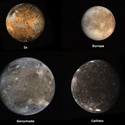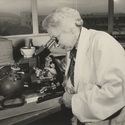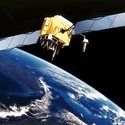Since the earliest times, humans have made observations of the night sky. These observations, particularly of the Earth, Moon, Sun and planets (visible to the naked eye), led to the development of models to explain the movement of these natural satellites as seen in the night sky.
With the development of the telescope, more accurate measurements of night sky objects were possible. This, along with the development of a more ‘scientific’ interpretation of the collected evidence1, caused a major shift from an Earth-centred view (geocentric) of the Universe2 to a Sun-centred one (heliocentric).
Ptolemaic model
In the second century CE, Ptolemy, who lived in the Egyptian town of Alexandria, produced a mathematical representation based on observation of the known Solar System3. In Ptolemy’s model, the Earth was at the centre of the Universe, with the Sun and planets revolving in a series4 of circular orbits moving out from the Earth. This model became known as the ‘geocentric’ model.
Copernican model
Nicolas Copernicus (1473–1543) was a Polish scholar who reconstructed Ptolemy’s model of the Universe. Over the 1200 years since Ptolemy’s model was put forward, it had been developed into a complex and cumbersome mathematical system. Copernicus was able to simplify it by switching from an Earth-centred model to a Sun-centred one.
The Roman Catholic Church, whose teachings held firmly to the Ptolemaic model, rejected his ‘heliocentric’ ideas. Copernicus’s work was banned and remained out of favour until 1822.
Tycho Brahe
The Dane Tycho Brahe (1546–1601) was born 3 years after the death of Copernicus. He studied mathematics and astronomy in German and Swiss universities and came to the conclusion that the Copernican model defied God’s word as written in the scriptures. He proposed a model with the Sun revolving around the Earth and the planets orbiting the Sun.
Tycho Brahe observed the motions of stars and planets and recorded their movements. He had an island observatory equipped with the best available instruments of the time (minus the telescope since it had not been invented). Years of careful observation allowed him to catalogue, with an exceptionally high degree of accuracy5, the positions of stars and the movement of the visible planets. In 1572, he observed the appearance of a very bright new star6. This was controversial because the belief of the time was that the stars were fixed. Tycho had observed a supernova7, now named SN 1572.
Kepler – laws of planetary motion
Shortly before his death, Tycho Brahe appointed as his assistant a young German, Johann Kepler (1571–1630). Kepler took over Brahe’s records and edited and extended them with his own observations. Kepler, who was a follower of the Copernican model, realised the orbits of the planets could be elliptical rather than circular.
Using Brahe’s data8 on the movement of Mars, Kepler developed his laws of planetary motion.
- The orbit9 of every planet10 is an ellipse with the Sun at one of the two foci.
- A line joining a planet and the Sun sweeps out equal areas during equal intervals of time.
- The square of the orbital period of a planet is directly proportional to the cube of the semi-major axis of its orbit.
These laws added considerable weight to the acceptance of the heliocentric model of the Universe.
Galileo discovers Jupiter’s moons
Galileo (1564–1642) lived at the same time as Kepler but they were not in regular communication. Using the newly discovered telescope, Galileo discovered that Jupiter had four moons. At first, he thought they were stars, but he noticed that, each night, the four points of light appeared to change positions slightly.
Galileo’s discovery of four of Jupiter’s moons was evidence that objects can orbit around other objects. He argued that if moons orbit around other planets, then perhaps the Earth is not the centre of all motion of the stars and planets. Galileo stated that the Earth and the planets must all orbit around the Sun (heliocentric).
1500 years ago, everybody knew the Earth was the centre of the Universe. 500 years ago, everybody knew the Earth was flat… Imagine what you’ll know tomorrow.
Agent K (Tommy Lee Jones) in the movie Men in Black
Nature of science
Science ideas and models often develop and change over time. It took many years after the invention of the telescope for people to agree that the Earth was not the centre of the Universe. Galileo’s telescope showed that moons could orbit around planets. This gave evidence to help prove that planets orbit around the Sun.
Newton and gravity
Sir Isaac Newton (1642–1727) was born in the same year that Galileo died. His studies of the motion of objects on Earth and of natural satellites in the night sky resulted in three laws of motion and a law of universal gravitation. He linked universal gravitation to Kepler’s laws of planetary motion. This monumental discovery meant that the heliocentric model of the Solar System was finally accepted by the scientific community
The journey from the geocentric to the heliocentric model was a long and tortuous one. It was the collection of empirical11 evidence along with mathematical applications in conjunction with insightful deep-thinking minds that finally replaced the geocentric model with the heliocentric one.
Activity idea
Find Jupiter’s moons with a pair of binoculars or a telescope in this activity, Observing natural satellites.
Useful links
Set the time and date on this interactive to investigate how Jupiter’s four biggest moons move.
View an animated representation of Newton’s law of gravitation that all satellites and projectiles obey. The yellow dots represent objects thrown up from the surface of the Earth. They follow a parabolic trajectory12.
- evidence: Data, or information, used to prove or disprove something.
- universe: All matter and energy, including the Earth, the galaxies and the contents of intergalactic space, regarded as a whole.
- Solar System: The Sun and objects in orbit around it, including the planets and their moons, asteroids and comets. The Sun is a star like many others in the galaxy.
- series: An electrical circuit layout where components are connected one after the other so that the current passes in a single path through the components.
- accuracy: In science, accuracy indicates the closeness of the measurements to the true or accepted value. In general usage, accuracy can mean precise, exact or correct.
- star: A self-luminous celestial body consisting of a mass of gas held together by its own gravity.
- supernova: A rare celestial event involving the explosion of most of the material in a star, resulting in an extremely bright, short-lived object that emits vast amounts of energy.
- data: The unprocessed information we analyse to gain knowledge.
- orbit: The path of an object as it revolves around another object. For example, the path the Moon takes as it moves around the Earth is its orbit.
- planet: In our Solar System, a planet is defined as an object that orbits the Sun, is big enough for its own gravity to make it ball-shaped and keeps space around it clear of smaller objects.
- empirical: Based on observation.
- trajectory: An arc (path) made (or likely to be made) by an object, such as a bullet or a launched rocket, as it moves from its launch position to its point of impact. The moving object has had some force applied to it to set it moving on its path.









